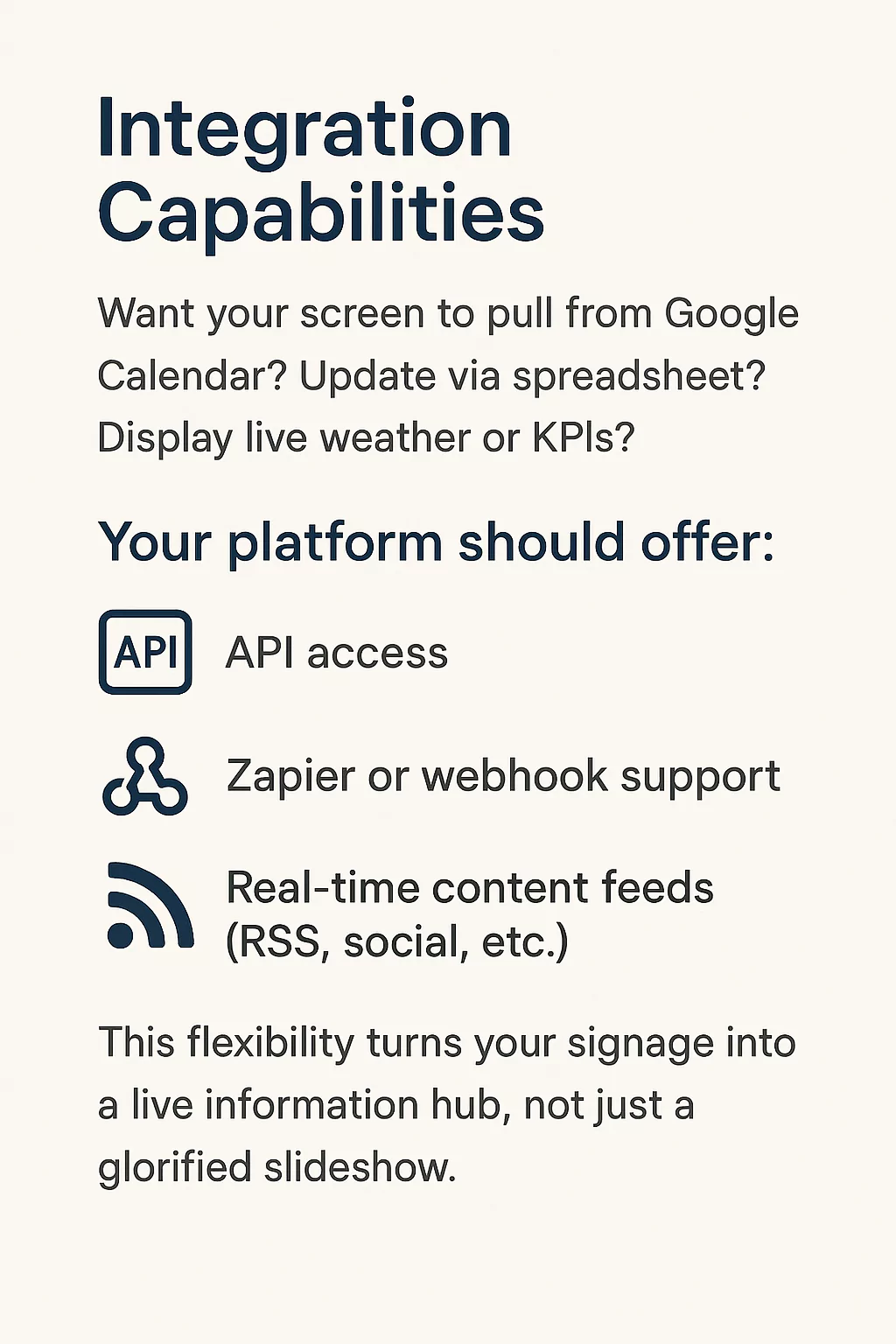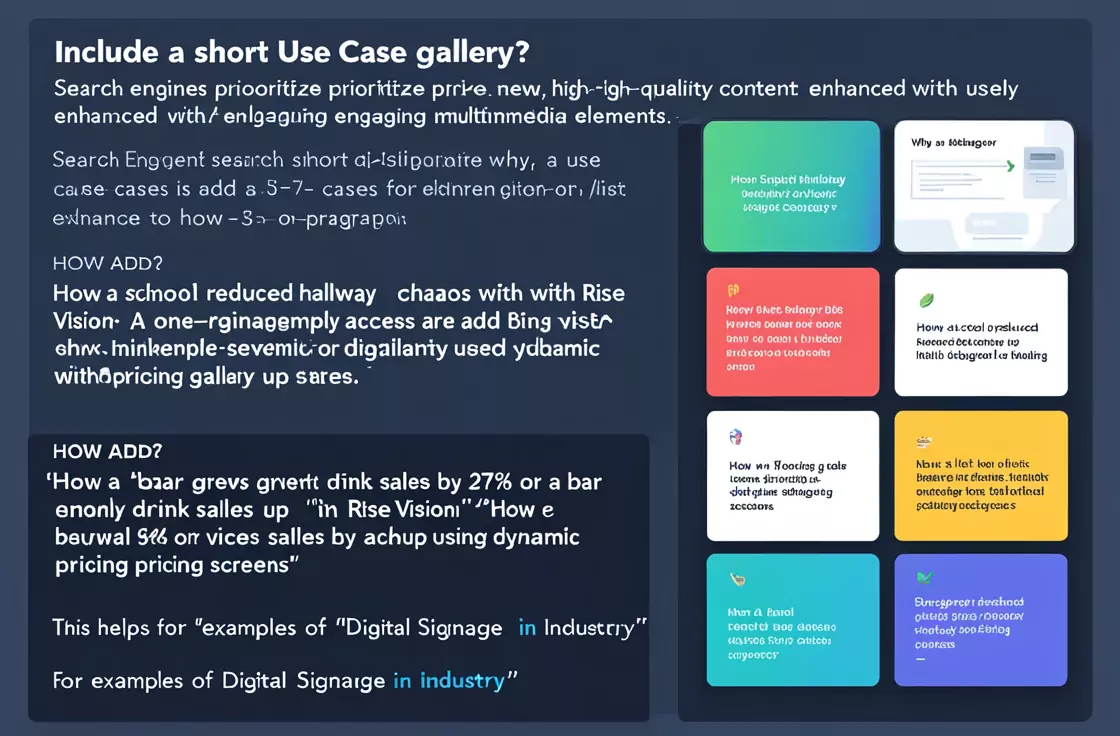Reviews & Comparison Of Top Digital Signage Companies
Top Digital Signage Companies | Reviews & Comparison
In an age where consumers are bombarded with over 4,000 marketing messages a day, how do you make yours stick? Enter digital signage—the silent sales superhero hiding in plain sight. Whether it’s the glowing menu at your favorite café or the sleek screen in a retail store prompting you to try something new, digital signs aren’t just flashy displays—they’re profit-driving machines.
And the numbers don’t lie:
63% of shoppers say digital signage grabs their attention better than traditional print ads.
Projections indicate that the worldwide market could grow to an impressive $27.8 billion by 2027.
However, there’s an important distinction to make: digital signage options can vary significantly in quality and features. Choosing the wrong provider or hardware can lead to frozen displays during peak hours, clunky interfaces that drain your team’s time, and contracts stuffed with hidden fees. That’s not just frustrating—it’s expensive.
In this section, we’ll unpack why digital signage deserves a front-row seat in your growth strategy—and how to dodge the costly mistakes that sabotage ROI before you even launch.
Why Digital Signage is Your Silent Sales Superhero (And How to Avoid Costly Mistakes)
Walk into any high-performing retail store, airport, hospital, or restaurant today, and chances are you’ll see it: glowing, dynamic screens guiding, selling, and engaging—without a single word spoken. These aren’t just high-tech decorations. They’re digital signage systems, and they’re quietly reshaping how modern businesses convert foot traffic into revenue.

The Booming Industry You Can’t Ignore
Recent market research indicates that the digital signage sector is expected to reach $27.8 billion by 2027. This rapid expansion is driven by the rise of smart cities, advancements in healthcare technology, and retailers adopting innovative solutions to enhance customer engagement. From fast-food drive-thrus to luxury showrooms, digital displays are no longer optional—they’re strategic infrastructure.
What’s driving this surge? Three core factors:
- Real-time content control – Swap promotions in seconds based on time of day or inventory levels.
- Higher engagement – Motion and interactivity capture attention far better than static posters.
- Data-backed optimization – AI and analytics allow businesses to test messaging and track impact in real time.

The Real ROI: Sales, Speed, and Customer Experience
Studies show that digital signage has the potential to increase sales by 15–30%, demonstrating its clear impact. How does it work?
- Reduced perceived wait times: A customer distracted by content feels like they’ve waited less.
- Upselling in real time: Flash deals, limited-time bundles, and high-margin products can be promoted dynamically.
- Consistency across locations: Franchise and multi-site businesses can roll out campaigns instantly and uniformly.
Even a single screen at a checkout counter can pay for itself within months if used strategically.
Avoiding the Common (and Costly) Pitfalls
Yet despite the upside, many businesses fall into the same traps—often due to lack of research or slick sales pitches:
- Crash-prone systems during peak hours: Choosing cheap, untested hardware or providers with unreliable uptime can leave screens frozen when you need them most.
- Clunky interfaces: Some platforms require hours of training or confusing scheduling tools, stealing 10+ hours per month from your staff.
- Hidden fees: Watch for vendors who advertise “free” software, but charge extra for features like remote management, integrations, or analytics.
Always request a demo and test how intuitive the platform feels. If it takes more than 5 minutes to upload and schedule a promo, it’s probably the wrong tool.
Top 10 Titans of currently: Who Rules the Screen?
Choosing a digital signage provider isn’t just about software—it’s about choosing a partner for growth. Whether you’re a global airport, a school cafeteria, or a boutique retail chain, the right platform can make or break your digital experience. In this updated list, we break down the industry leaders, showing not just what they offer—but why they matter.
The Global Standouts – Comparison Table

Company | Best For | Pricing (Start) | Unique Edge |
Scala | Enterprise (Fortune 500) | Custom | Trusted by NASA & BMW for mission-critical displays |
Yodeck | SMBs & Restaurants | Free (1 screen) | Plug-n-play in 5 mins; offline mode via WiFi |
BrightSign | Hardware Reliability | $199/player | |
Broadsign | DOOH Advertising | Campaign-based | |
Four Winds (FWI) | Airports & Large Venues | $50+/screen/month | Real-time integrations for flight, weather, traffic |
Rise Vision | Schools & NGOs | Free tier | Interactive campus signage & templates |
Look beyond pricing—focus on scalability, offline capabilities, and customer support responsiveness.
Regional Powerhouses You Should Know
Digital signage isn’t one-size-fits-all. Local needs matter. Here’s who’s dominating across key regions:
🇮🇳 India:
- Inresto – Restaurant-focused, integrates with POS systems.
- Prama – Trusted for secure, government-grade signage.
- BenQ – Touch displays in retail kiosks & smart education.
🇪🇺 Europe:
- Signagelive – Strong in transport networks and retail rollouts.
- Cisco Vision – Stadiums and public transit rely on its scale.
Worldwide Leaders:
- Samsung & LG – Best-in-class commercial-grade display hardware.
- ScreenCloud – Cloud-based signage that’s easy for non-tech teams.
How to Choose: Context Is Everything
Ask yourself:
- Do I need centralized control across locations? → Go with Broadsign or Four Winds.
- Am I a restaurant or cafe needing fast setup? → Yodeck is your ally.
- Is offline playback mission-critical (e.g., elevators, rural areas)? → Verify that your platform allows for caching and local media playback.

Many providers look similar until you dig into use cases. For example, Yodeck’s free tier is ideal for SMBs, but a fast-scaling enterprise might need BrightSign’s bulletproof hardware combined with Broadsign’s ad network tools.
Top Digital Signage Companies | Let’s talk about 30 best
# | Company | HQ Country | Founded | Core Specialty |
|---|---|---|---|---|
1 | Samsung Electronics | South Korea | 1938 | LED/OLED Displays, Smart Signage |
2 | LG Electronics | South Korea | 1958 | Commercial Displays, Transparent Screens |
3 | NEC Display Solutions | Japan | 1899 | Large-Venue Displays, Airports |
4 | Sharp/NEC | Japan | 2019 | Unified Display Tech (Joint Venture) |
5 | Planar Systems | USA | 1983 | Video Walls, Control Rooms |
6 | Daktronics | USA | 1968 | Sports Arenas, Outdoor LED |
7 | Scala | USA | 1987 | Enterprise CMS (Acquired by STRATACACHE) |
8 | Broadsign | Canada | 2005 | Programmatic DOOH Advertising |
9 | BrightSign | USA | 2002 | Ultra-Reliable Media Players |
10 | Yodeck | Greece | 2015 | Free Tier for SMBs, Raspberry Pi-Based |
11 | ScreenCloud | UK | 2015 | Cloud Platform, App Integrations |
12 | Four Winds Interactive | USA | 2003 | Large-Scale Corporate/Healthcare |
13 | Signagelive | UK | 2003 | GDPR-Compliant Cloud CMS |
14 | NoviSign | Israel | 2012 | Budget-Friendly Retail Solutions |
15 | Rise Vision | Canada | 1992 | Education & Nonprofits |
16 | Cisco | USA | 1984 | Digital Ceiling (Smart Building Displays) |
17 | BenQ | Taiwan | 2001 | Interactive Flat Panels |
18 | ViewSonic | USA | 1987 | Education & Collaboration Displays |
19 | Leyard/Planar | China | 1995 | LED Video Walls (Acquired Planar in 2016) |
20 | Christie Digital | Canada | 1929 | Projection Mapping, Giant Screens |
21 | Barco | Belgium | 1934 | Control Rooms, Medical Imaging Displays |
22 | ADFLOW Networks | Canada | 2001 | Retail & Gas Station Networks |
23 | Mvix | USA | 2004 | Government & University Solutions |
24 | Inresto | India | 2010 | Restaurant Kiosks, QSR Chains |
25 | Prama India | India | 1996 | Transport Hubs, Digital Billboards |
26 | Prismview | USA | 2012 | Large-Scale Outdoor LED (Samsung Subsidiary) |
27 | AOPEN | Taiwan | 1996 | Digital Signage PCs |
28 | Navori Labs | Switzerland | 1999 | AI-Driven Content Analytics |
29 | Onelan | UK | 2001 | Corporate Comms (Part of Tripleplay) |
30 | SpinetiX | Switzerland | 2008 | UltraHD Media Players |
The Ultimate Selection Checklist: 7 Make-or-Break Factors
Buying digital signage software isn’t like choosing a Netflix plan. It’s a decision that affects your brand visibility, team efficiency, and revenue growth—every single day. But with hundreds of providers touting the “best features,” how do you actually separate the hype from what really matters?
This checklist zeroes in on the 7 core factors that will make—or break—your investment.

1. True Cost (and the Hidden Traps)
Digital signage pricing ranges from $20 to $200+ per screen/month, depending on features, scale, and support.
But here’s the kicker: some “free” tools come with costly add-ons—remote access, analytics, or even HD playback might be locked behind paywalls.
Smart Tip:
- Avoid long-term contracts. Over 83% of top providers offer monthly plans—don’t get locked into bad tech for 2 years.
2. ROI Clarity – Will This Actually Pay Off?
Let’s say you invest $500/month on signage hardware, software, and content. If your screens drive $1,500 in upsells, ads, or customer retention, you’ve tripled your money.
ROI Formula:
Monthly Screen Cost → Monthly Screen Revenue (upsells, ads, retention boosts) → Break-even timeline
Pro Move: Track high-margin product lifts and reduced wait-time complaints to quantify signage impact.
3. Hardware Compatibility: Don’t Get Boxed In
The screen is only half the story. What powers it matters more:
- Raspberry Pi: Budget-friendly, solid for basic displays.
- BrightSign: Ultra-reliable, built for 24/7 enterprise environments.
- Android-based players: Versatile, easy to replace, good for moderate use.

Key Question: Does the software require specific hardware to function, or can it be used with different devices? If yes, tread carefully.
4. Ease of Use – Can Anyone On Your Team Operate It?
A great digital signage tool empowers your staff—not buries them in YouTube tutorials.
- Need to upload, schedule, and edit content in less than five minutes?
- Is there a mobile app or drag-and-drop editor?
- How intuitive is playlist creation?
Friction costs hours, and lost hours mean lower returns.
5. Offline Mode – Will It Still Work Without Internet?
In remote sites, elevators, or power-fluctuating zones, a lost signal shouldn’t mean a black screen.
Offline-capable platforms (like Yodeck or NoviSign) cache content locally, ensuring playback even if WiFi drops.
Ask This: “What happens when the internet goes down for an hour?”
6. Integration Capabilities
Want your screen to pull from Google Calendar? Update via spreadsheet? Display live weather or KPIs?

Your platform should offer:
- API access
- Zapier or webhook support
- Real-time content feeds (RSS, social, etc.)
This flexibility turns your signage into a live information hub, not just a glorified slideshow.
7. Customer Support – Invisible Until It’s Urgent
Ask any business owner: the real test of a vendor is when things break.
- Do they offer live chat or only email tickets?
- Is support included in your tier or upsold?
- What’s their average response time?
Test their support before you buy. Ask a tough pre-sales question and track how fast they respond—and how clearly.
Profit Playbook: Turning Screens Into Revenue Machines
Most businesses install digital signage to “look modern”—but the smart ones use it to make serious money. Done right, a single screen can become one of your highest-performing assets, boosting sales, unlocking ad revenue, and even opening up new job roles. This isn’t about decoration—it’s about activation.
1. Monetize Attention: Sell Ad Space on Your Screens

Treat your digital screens like prime advertising space—every second of display is a valuable opportunity.
- Local advertising: Cafes, gyms, salons, and clinics can earn $200–$500/month per screen by running ads for local businesses (Broadsign-backed case study).
- Cross-promotion: Franchises can upsell across locations by featuring sister brands.
- Programmatic DOOH (Digital Out-of-Home): With platforms like Broadsign or Vistar Media, you can join large-scale ad networks and let national brands buy time on your displays—passively.
Ideal For: Hospitality, retail, fitness centers, gas stations, transit hubs.
2. Upsell Smarter: Let the Screen Do the Suggesting
Digital menus aren’t just digital—they’re dynamic.
- AI-powered suggestions: McDonald’s uses customer behavior data to show recommended add-ons, increasing average order value by 18%.
- Timed promotions: Auto-switch breakfast-to-lunch specials based on time of day.
- Inventory-aware displays: Push overstock items in real time (e.g., “Buy 1 Get 1 Free – Today Only!”).
Hot Tip: Use screen zones—top bar for branding, middle for high-margin items, bottom ticker for promotions.
3. New Roles, New Revenue: Meet the Digital Signage Manager
As signage networks grow, someone needs to run the show. That’s where Digital Signage Managers come in—professionals who coordinate content, performance tracking, hardware maintenance, and campaign execution.
Why it matters: If your company or client base is scaling, offering signage management as a service (or role) is a value-add that justifies retainers and upsells.
4. Pro-Tier Revenue Strategy: Combine All Three
The most profitable digital signage setups don’t choose one tactic—they blend all three:
- Monetize unused screen time
- Push high-margin SKUs dynamically
- Delegate the task to a specialist or agency to enhance results.

Result: Predictable monthly revenue + lower customer churn + increased in-store spend.
The Future is Transparent (Literally) + Your Next Step

If today’s digital signage helps you sell, tomorrow’s will help you predict, personalize, and outperform. Screens are no longer just content containers—they’re becoming intelligent, interactive surfaces embedded into everyday life.
AI Personalization: Real-Time, Customer-Aware Content
Imagine walking past a digital sign that instantly knows you’re a 30-something parent on a rainy day—and shows you a nearby kids’ event with discounted tickets. This isn’t sci-fi. It’s already happening.
- Cameras + AI are being used to detect age, gender, and mood—then adjust the content accordingly.
- Retailers like Walgreens use this tech to promote age-specific items like vitamins or skincare to the right demographic at the right moment.
- With GDPR/CCPA in mind, these systems rely on anonymous data, focusing on behavioral patterns, not personal identities.
Your screen can act like a smart salesperson—tailoring the pitch in real time.

Holographic and Transparent Displays: From Innovation to Affordability
The next wave of screens isn’t just digital—it’s dimensional.
- Transparent OLEDs: Picture a store window that shows products and content, without blocking visibility. Brands like Adidas and Tesla are testing this now.
- Holographic 3D Displays: Porsche is piloting showroom kiosks where customers can walk around a 3D car model before speaking to sales.
- Gesture and voice controls: Soon, touching a screen may be optional. Touchless UX is gaining traction post-COVID.
Why It Matters: These innovations aren’t just for flash—they increase engagement, reduce friction, and turn passive viewers into active participants.
Sustainability Meets Tech: Greener Signage Is Good Business
Digital signage isn’t just smarter—it’s cleaner.
- Solar-powered displays are already cutting energy use by up to 40% in outdoor setups.
- Unlike traditional illuminated signs, LED and e-paper screens consume far less energy, resulting in fewer emissions.
- Lifecycle ROI: Although upfront hardware costs may be higher, sustainable signage often has lower TCO (total cost of ownership) over time.
Green Bonus: Brands showcasing sustainability in signage often boost consumer trust and loyalty.
What Should You Do Next?
Innovation is accelerating—but implementation is still simple. Here’s how to take the next smart step:
- Try Yodeck for free – No coding. One screen. Five-minute setup.
- Compare 3 top providers with a quote tailored to your business type.
- Audit your existing signage and identify missed revenue or engagement opportunities.
The businesses getting ahead are those who treat signage as a marketing channel—not just a tech purchase.
Enhance Understanding with a Mini-Glossary or Tooltip Feature for Technical Terms

Why? Google’s NLP favors helpful content that demystifies complex terms.
How? Brief in-line definitions or expandable tooltips for:
- “DOOH” (Digital Out-of-Home)
- “Raspberry Pi”
- “CMS” (Content Management System)
- “Offline playback”
This reduces bounce rate by making content friendlier to beginners—without dumbing it down.
Integrate Visual Schema FAQs at the End
Why? Featured snippets and voice search often pull from FAQ-rich schema.
Suggested FAQ entries:
- Can you explain digital signage and how it functions?
- What’s the average cost to install digital signage?
- Can digital signage work without internet?
- Is digital signage profitable for small businesses?
These increase SEO real estate and align with people-also-ask boxes.
Embed a CTA with Intent-Based Internal Linking

Why? Boosts site structure and keeps readers exploring.
How? Add contextual internal links like:
- “See how Starbucks uses digital signage for upselling” → case study
- “Compare pricing tiers across providers” → product/service page
This improves click depth and passes authority between key pages.
Target Long-Tail & Niche Search Queries
Your keywords are strong, but adding questions and how-to phrasing will catch high-intent searches. Consider sprinkling in:
- “how to set up digital signage in a small business”
- “digital signage for cafes under $50/month”
- “best free digital signage CMS”
This taps low-competition SERPs and helps dominate vertical-specific queries.
Include a Short Use Case Gallery
Why? Search engines prioritize new, high-quality content enhanced with engaging multimedia elements.
How? Add:
- 3–5 one-paragraph use cases (e.g., “How a school reduced hallway chaos with Rise Vision” or “How a bar grew drink sales by 27% using dynamic pricing screens”)
- Link each to a visual or mockup

This helps rank for “examples of digital signage in ___ industry.”
Conclusion: Your Screens Are More Than Just Displays—They’re Profit Engines
Digital signage is no longer a “nice-to-have.” It’s a proven, data-backed growth tool that smart businesses are using to attract customers, boost sales, and unlock recurring revenue—all while enhancing brand visibility.
Whether you’re a small business owner looking for the best digital signage software, an enterprise comparing top signage platforms, or a marketer exploring future signage trends, the opportunity is clear:
✅ Choose the right solution.
✅ Avoid costly setup mistakes.
✅ Turn every screen into a strategic asset.
And the best part? You can get started today, with zero technical skills and a free trial that lets you test the waters.
Next Step:
- Start your free Yodeck trial – no credit card, no risk.
- Or compare personalized quotes from 3 vetted providers to match your industry, screen count, and budget.
Still unsure which setup fits your goals? Let us guide you—get expert advice on digital signage for your business.
FAQs
Broadsign dominates Digital Out-of-Home (DOOH) advertising globally, powering over 1 million screens (e.g., Times Square billboards). For enterprise software, Scala and Four Winds Interactive (FWI) lead in Fortune 500 deployments.
Based on reliability, features & user reviews:
Yodeck (best for SMBs)
BrightSign (top hardware)
ScreenCloud (cloud simplicity)
Scala (enterprise scale)
Broadsign (DOOH advertising)
Yes:
- Ad revenue: A single screen in a cafe earns $200–$500/month from local ads.
- Upselling: Dynamic menus boost sales by 15–30% (e.g., McDonald’s combo promotions).
- Cost savings: Replaces print materials – saves $3k+/year for mid-sized businesses.
$1,000–$5,000+ (one-time):
- Software: $10–$200/month per screen (Yodeck: free 1-screen plan).
- Hardware: $150–$2,000 per display (BrightSign players start at $199).
- Installation: $50–$150/hour. Tip: Cloud solutions cut setup costs by 70%.
Yes! Companies like Yodeck, NoviSign, and BrightSign offer offline modes. Content plays automatically via local storage (SD cards/media players) – ideal for elevators, transit, or remote sites.
Depends on use:
- Android: Flexible, app-friendly (e.g., Samsung displays).
- BrightSign OS: Ultra-reliable for 24/7 operations (airports/billboards).
- Linux (Raspberry Pi): Budget-friendly (Yodeck’s specialty).
Key 2025–2030 trends:
- AI personalization: Screens show targeted ads based on audience demographics.
- Touchless interactivity: Gesture control + AR (e.g., virtual try-ons).
- Sustainability: Solar-powered screens + recycled materials.
- India: Inresto (retail kiosks), BenQ (hardware), Prama (transport hubs).
- Europe: Signagelive (UK cloud software), Cisco Vision (smart cities), Sharp/NEC (displays).
$75,000–$120,000/year (Glassdoor 2024) – varies by location/scale. Skills in CMS platforms (e.g., ScreenCloud, Scala) boost earnings.
Absolutely:
- ROI: Pays off in 3–6 months (e.g., restaurant menus reduce perceived wait times + boost orders).
- Entry cost: As low as $0 (Yodeck’s free plan) + a $200 Fire TV stick.


